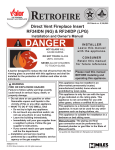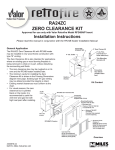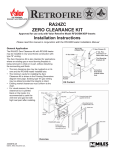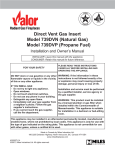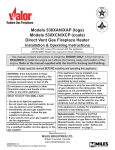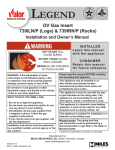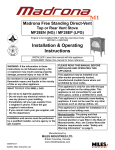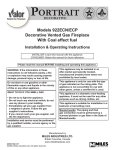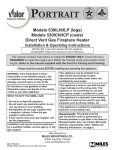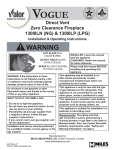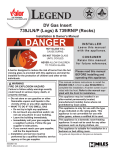Download Valor RetroFire RF24DP Owner`s manual
Transcript
Model RF24BN/BP Gravity Vent Fireplace Insert Patents Pending Installation and Owner’s Manual ! WARNING WARNING HOT GLASSWILL WILL HOT GLASS CAUSEBURNS. BURNS. CAUSE DO TOUCHGLASS GLASS DO NOT NOT TOUCH UNTIL COOLED. UNTIL COOLED. NEVER ALLOW CHILDREN NEVER ALLOW CHILDREN TO TOUCH GLASS. TO TOUCH GLASS. WARNING: If the information in these instructions is not followed exactly, a fire or explosion may result causing property damage, personal injury or loss of life. Do not store or use gasoline or other flammable vapors and liquids in the vicinity of this or any other appliance. WHAT TO DO IF YOU SMELL GAS • Do not try to light the appliance. • Do not touch any electrical switch; do not use any phone in your building. • Immediately call your gas supplier from a neighbor’s phone. Follow the gas supplier’s instructions. • If you cannot reach your gas supplier, call the fire department. Installation and service must be performed by a qualified installer, service agency or the gas supplier. INSTALLER: Leave this manual with the appliance. CONSUMER: Retain this manual for future reference. Please read this manual BEFORE installing and operating this appliance. This appliance may be installed in an after-market permanently located, manufactured (mobile) home where not prohibited by local codes. This appliance is only for use with the type of gas indicated on the rating plate. This appliance is not convertible for use with other gases, unless a certified kit is used. This appliance is a domestic room-heating appliance. It must not be used for any other purposes such as drying clothes, etc. This appliance is suitable for installation in a bedroom or bed sitting room. Massachusetts: The piping and final gas connection must be performed by a licensed plumber or gas fitter in the State of Massachusetts. Manufactured by MILES INDUSTRIES LTD., British Columbia, Canada www.valorfireplaces.com 4001003-12 © 2010 Miles Industries Ltd. All rights reserved Thank You ... For purchasing a Valor Retrofire. Your new radiant gas heater is a technical appliance that must be installed by a qualified dealer. Each Retrofire is fully tested during the production process for your safety and comfort. Your unit has been professionally installed by: Dealer Name _______________________________________ Phone Number ______________________________________ Should you encounter an operational problem, call your dealer immediately. Do not try to repair the unit as you may cause an injury or damage the fireplace. The information contained in this installation manual is believed to be correct at the time of printing. Miles Industries Ltd. reserves the right to change or modify any information or specifications without notice. Miles Industries Ltd. grants no warranty, implied or stated, for the installation or maintenance of your heater, and assumes no responsibility for any consequential damage(s). Fireplace Hearth We recommend that our gas hearth products be installed and serviced by professionals who are certified in the United States by NFI (National Fireplace Institute®). Do not put furniture or other objects in this space in front of the fireplace: 36” (0.9 m) Designed and Manufactured by / for Miles Industries Ltd. 190–2255 Dollarton Highway, North Vancouver, BC, CANADA V7H 3B1 Tel. 604-984-3496 Fax 604-984-0246 www.valorfireplaces.com © Copyright Miles Industries Ltd., 2010 2 Table of Contents Safety and Warning Information.......................................................... 4 ◊ Specifications........................................................................................ 5 Dimensions and Clearances................................................................. 6 Venting.................................................................................................... 7 Existing Fireplace Preparation............................................................. 8 Supply Gas............................................................................................. 9 Vent Liner Rough-In............................................................................. 10 Appliance Preparation......................................................................... 10 Firebox Installation.............................................................................. 11 Ceramic Fuel Bed Installation............................................................ 13 Window Refitting................................................................................. 14 ◊ Remote Control Installation................................................................ 15 Operation Check and Aeration Adjustment...................................... 15 Vent Check........................................................................................... 16 Cast Iron Fret Installation................................................................... 16 Owner’s Information............................................................................ 17 Remote Control Operation.................................................................. 18 Options................................................................................................. 20 Lighting Instructions........................................................................... 21 Warranty............................................................................................... 22 ◊ Parts...................................................................................................... 23 ◊ = Updated content 3 Safety and Warning Information READ and UNDERSTAND all instructions carefully before starting the installation. FAILURE TO FOLLOW these installation instructions may result in possible fire hazard and will void the warranty. Prior to the first firing of the fireplace, READ the Owner’s Information section of this manual. DO NOT USE this appliance if any part has been under water. Immediately, CALL a qualified service technician to inspect the unit and to replace any part of the control system and any gas control that has been under water. THIS UNIT IS NOT FOR USE WITH SOLID FUEL. This unit MUST be used with a vent system as described in this installation manual. NO OTHER vent system or components MAY BE USED. This gas fireplace and vent assembly MUST be vented directly to the outside and MUST NEVER be attached to a chimney serving a separate solid fuel burning appliance. Each gas appliance MUST USE a separate vent system. Common vent systems are PROHIBITED. INSPECT the external vent cap on a regular basis to make sure that no debris, plants, trees, shrubs are interfering with the air flow. Installation and repair should be PERFORMED by a qualified service person. The appliance and venting system should be INSPECTED before initial use and at least annually by a professional service person. More frequent cleaning may be required due to excessive lint from carpeting, bedding, etc. It is IMPERATIVE that the unit’s control compartment, burner, and circulating air passageways BE KEPT CLEAN to provide for adequate combustion and ventilation air. The glass door assembly MUST be in place and sealed before the unit can be placed into safe operation. Always KEEP the appliance clear and free from combustible materials, gasoline, and other flammable vapors and liquids. DO NOT USE abrasive cleaners on the glass door assembly. DO NOT ATTEMPT to clean the glass door when it is hot. NEVER OBSTRUCT the flow of combustion and ventilation air. Keep the front of the appliance CLEAR of all obstacles and materials for servicing and proper operation. Due to the high temperature, the appliance should be LOCATED out of traffic areas and away from furniture and draperies. Clothing or flammable material SHOULD NOT BE PLACED on or near the appliance. Children and adults should be ALERTED to the hazards of high surface temperature and should STAY AWAY to avoid burns or clothing ignition. Young children should be CAREFULLY SUPERVISED when they are in the same room as the appliance. Toddlers, young children and others may be susceptible to accidental contact burns. A physical barrier is recommended if there are at risk individuals in the house. To restrict access to a fireplace or stove, install an adjustable safety gate to keep toddlers, young children and other at risk individuals out of the room and away from hot surfaces. 4 DO NOT OPERATE this appliance with the glass door removed, cracked, or broken. Replacement of the glass door should be performed by a licensed or qualified service person. DO NOT strike or slam the glass door. The glass door assembly SHALL ONLY be replaced as a complete unit, as supplied by the fireplace manufacturer. NO SUBSTITUTE material may be used. Turn off the gas before servicing this appliance. It is recommended that a qualified service technician perform an appliance check-up at the beginning of each heating season. Any safety screen or guard removed for servicing must be replaced before operating this appliance. DO NOT place furniture or any other combustible household objects within 36” of the fireplace front. BE CAREFUL not to put any decorating objects sensitive to heat to close above or around the fireplace as it gets very hot when operating. DO NOT use this heater as a temporary source of heat during construction. This appliance is a DOMESTIC ROOM-HEATING APPLIANCE. It must not be used for any other purposes such as drying clothes, etc. State of California. Proposition 65 Warning. Fuels used in gas, wood-burning or oil fired appliances, and the products of combustion of such fuels, contain chemicals known to the State of California to cause cancer, birth defects and other reproductive harm. California Health & Safety Code Sec. 25249.6. Safety and Warning Information Operating Your Fireplace for the First Time. When operating your new fireplace for the first time, some vapors may be released due to the burning of curing compounds used in the manufacture of the appliance. They may cause a slight odor and could cause the flames to be the full height of the firebox, or even slightly higher, for the first few hours of operation. It is also possible that these vapors could set off any smoke detection alarms in the immediate vicinity. These vapors are quite normal on new appliances. We recommend opening a window to vent the room. After a few hours use, the vapors will have disappeared and the flames will be at their normal height. Specifications This appliance as supplied is intended for installation into existing masonry or factory built solid-fuel burning fireplaces only, unless the separately supplied Zero Clearance Kit RA24ZC is used. See separate instructions packaged with the Zero Clearance Kit. Approvals and Codes This appliance is certified to ANSI Z21.88-2009 / CSA 2.33-2009 American National Standard / CSA Standard for Vented Gas Fireplace Heaters for use in Canada and the USA and to CGA 2.17-91 High Altitude Standard in Canada. Model RF24BVN is for use with Natural Gas only. Model RF24BVP is for use with LPG only. Conversion between fuels may only be done using the approved conversion kits listed in the section Options. This appliance complies with CSA P4.1-09 Testing method for measuring annual fireplace efficiencies. The installation must conform to local codes or, in the absence of local codes with the National Fuel Gas Code, ANSI Z223.1 or the Canadian Installation Code CAN/CGA-B149. Only qualified licensed or trained personnel should install this appliance. This appliance, when installed , must be electrically grounded in accordance with local codes, or in the absence of local codes, with the National Electrical Code, ANSI/NFPA 70 or the Canadian Electrical Code, CSA C22.1 *High Altitude Installations Input ratings are shown in BTU per hour and are certified without deration for elevations up to 4,500 feet (1,370 m) above sea level. For elevations above 4,500 feet (1,370 m) in USA, installations must be in accordance with the current ANSI Z223.1 and/or local codes having jurisdiction. In Canada, please consult provincial and/or local authorities having jurisdiction for installations at elevations above 4,500 feet (1,370 m). Ratings Model Gas Altitude (Ft.)* Input Maximum (Btu/h) Input Minimum (Btu/h) Manifold Pressure (in w.c.) Minimum Supply Pressure (in w.c.) Maximum Supply Pressure (in w.c.) Main Burner Injector Marking Pilot Injector Marking NG LPG Natural Propane 0-4,500 feet* 20,500 19,000 12,500 12,500 3.7 10.5 5.0 11.0 10.5 14.0 82-580 92-200 51 30 5 Dimensions and Clearances Dimensions—for Solid-Fuel Burning Fireplace Insert Only See separate framing Dimensions for Zero Clearance applications with the Zero Clearance Kit RA24ZC. 24-1/2” 24-3/8” 17” 8” Stand-offs 7-5/8” 1225VFB Ventana Fret (Black) 25-1/2” 4-1/2” Min. 12” Max. 14-3/4” 27” 11” 10” RA24CV Fret (Vintage Iron) 1” 24” Optional Frets Control Valve Location Min. 12” Max. 14-3/4” Top View 4-1/2” Adjustable Convection Baffle Smoke Channel for Checking Draft 1-3/4” Valve 24” 18/3/4” Fret Mounting Brackets (removeable) Gas Inlet 3/8” NPT Female Optional Cast Fret Vent Switch Location Optional Fan Speed Control Location (at front) 1-1/4” 20-1/2” Front Face of Cast Fret RA24AV Fret (Vintage Iron) 19” 4-1/2” RA24TB Fret (Black) 3” dia. Collar Levelling Bolt 13-1/4” 14-1/2” Front View Minimum Cavity Dimensions—For Solid-Fuel Burning Fireplace Insert (See separate framing dimensions for Zero Clearance applications in the Zero Clearance Kit RA24ZC.) The diagram shows minimum dimensions required to install the RF24. Installations in cavities having a combination of all the minimum dimensions shown, although possible, may prove to be difficult. Mantel / Hearth Clearances Combustible Mantel and Hearth Clearances for insert applications must conform to those required for the original solid-fuel burning fireplace in which the RF24 insert is being installed. NOTE: The glass front and hearth are very hot. Existing wire mesh screens or free standing hearth mounted mesh screens may be used in front of the RF24 insert to help minimize the chance of injury. 6 Side View Height of Smoke Curtain 20” 19-1/2” 18” 14” 28-1/2” Minimum Insert Cavity Venting Vent Materials Use a 3” diameter aluminium flex liner approved for gas venting when installing as an insert (existing chimneys). Use a 4” diameter type “B” vent when installing with a RA24ZC Zero Clearance Kit. See separate instructions packaged with the Zero Clearance Kit. The minimum vent lengths are shown below. For other allowable configurations, refer to the venting tables in the National Fuel Gas Code Z223.1 or the Natural Gas and Propane Installation Code B149.1. Approved Termination Required Min. 10 feet Max. 16” offset if vent height is minimal or elbow at collar of unit 3” Liner 3” min. Bend Radius Minimum Vent Liner Radius Allowable Vent Configurations WARNING Failure to position the parts in accordance with these diagrams or failure to use only parts specifically approved with this appliance may result in property damage or personal injury. 7 Existing Fireplace Preparation A few points must be considered before inserting the RF24 into an existing fireplace cavity. Generally, modifications to the existing fireplace that will compromise its integrity are NOT allowed. Components that are bolted or screwed on, such as dampers or baffles, may be removed to accommodate the installation of the RF24 engine. Cutting away any sheet metal parts off the existing fireplace to accommodate the installation of the RF24 is prohibited. Check with local authorities if in doubt. Clean Fireplace and Chimney Have the chimney swept and the fireplace cavity including ash dumps and clean-outs cleaned before installing the RF24 heater and vent liners. Any creosote or soot residue remaining in the fireplace cavity chimney or clean-out may cause odors or stains once the RF24 insert is installed. Consult with chimney sweep for information on how best to clean. Existing Dampers Factory-built, zero clearance fireplaces will require the damper to be removed in order to install the vent liners. These dampers are usually bolted into place. Dampers in masonry fireplaces must be fixed open and may remain in place. Ash Retaining Curbs Some fireplaces (particularly factory-built) have a raised curb at the front edge to retain ashes. Check the dimensions carefully to ensure the RF24 engine will fit behind any raised curb (some curbs may be removed separately from the refractory base). The fret retainers allow for some vertical adjustment of the cast iron fret should the fret need to sit on top of the curb, otherwise the fret will need to be eliminated or adequate room provided behind the curb. Gas Line Routing Plan the routing of the gas line before proceeding. Utilize the existing hole for the gas line. If the factory-built fireplace has no access hole, carefully drill an access hole of 1-1/2 inch (38 mm) or less through the lower sides or bottom of the firebox. The access hole must be plugged with non-combustible insulation after the gas supply line has been installed. See illustration in Dimensions section for detailed location of gas inlet. Also, take into consideration whether or not a fan or shut-off valve will interfere when planning the routing of the gas line. Existing Glass Doors and Wire Screens Existing glass doors must be permanently removed prior to installing the RF24 insert. Existing wire fire screens may remain in place or new ones may be added. The RF24 has been tested and approved to operate with wire fire screens in the closed or open positions. Combustible Mantels Combustible mantel clearances must conform to those required for the original solid-fuel fireplace into which the RF24 is being installed. Paint Existing Refractory Liners It may be desirable, for visual reasons, to paint the existing refractory liners in black to blend in with the RF24 insert once installed. Attach Warning Label to Existing Fireplace (label supplied loose with RF24 heater) Attach the label “This fireplace has been converted...” to the existing fireplace using screws or other mechanical means and store any removed parts in the back of the existing fireplace for future use. 8 Supply Gas • It is preferable to rough-in the gas line at this point before proceeding with the firebox installation. • The gas supply inlet connection is a 3/8” NPT female connector. For detailed location of this connector, see • • • • • • • • • • • • • illustration in section Dimensions. If a circulating fan or isolating valve is to be installed, adjust the routing of the gas line to suit. Use only new black iron or steel pipes or copper tubing if acceptable—check local codes. Note that in USA, copper tubing must be internally tinned for protection against sulfur compounds. Unions in gas lines should be of ground joint type. The gas supply line must be sized and installed to provide a supply of gas sufficient to meet the maximum demand of the appliance without undue loss of pressure. Sealant used must be resistant to the action of all gas constituents including LP gas. Sealant should be applied lightly to male threads to ensure excess sealant does not enter gas lines. The supply line should include a manual shut-off valve and union to allow the appliance to be disconnected for servicing. Pressure test the supply line for leaks. The appliance and its individual shut-off valve must be disconnected from the gas supply piping system during any pressure testing of that system at test pressures in excess of ½ psig (3.5 kPa). The appliance must be isolated from the gas supply piping system by closing its individual manual shutoff valve during any pressure testing of the gas supply piping system at test pressures equal to or less than ½ psig (3.5 kPa). Failure to either disconnect or isolate the appliance during pressure testing may result in regulator or valve damage. Consult your dealer in this case. The minimum supply pressure is given in the section Specifications of this manual. Inlet Pipe All piping and connections must be tested for leaks after installation or servicing. All leaks must be corrected immediately. When testing for leaks: • Make sure that the appliance is turned off. Manifold Pressure Test Tap • Open the manual shut-off valve. Supply Pressure Test Tap • Test for leaks by applying a liquid detergent or soap Loosen screw to check solution to all joints. Bubbles forming indicate a gas (tighten afterwards) Pressure Test Tappings leak. Never use an open flame to check for leaks. • Correct any leak detected immediately. The pressure test tapping locations are shown in figure above. A built-in non-adjustable regulator controls the burner manifold pressure. The correct pressure range is shown in the ratings table in section Specifications of this manual. The pressure check should be made with the burner alight and at its highest setting. See Lighting Instructions section for full operating details. 9 Vent Liner Rough-In Rough-in the 3” diameter vent liner into existing chimney system being careful not to tear or damage the liner in the process. Leave plenty of liner at the bottom end if the heater will be connected while on the hearth—see diagram in Connect Liner to the Firebox section. When connecting the liner in this manner, it is best to leave the top termination until later so the slack liner can be lifted after the insert is in place. 3” dia. Aluminum Liner Existing Fireplace Rough-In Liner Appliance Preparation The size of the existing fireplace cavity will affect the method of installation. Smaller fireplaces, particularly factorybuilt zero clearance fireplaces, will require the RF24 firebox to be disassembled and then reassembled inside the fireplace. Plan your installation accordingly. • • • • Unpack appliance. Remove window. Remove log pack from firebox. Strip firebox down by removing: •Burner module (4 screws); •Vent plate; •Support Legs (2 screws per leg) (required when inserting into small fireplaces only). Remove Vent Plate Remove Window Remove Burner Module (4 screws) Spring-Loaded Fastening Studs (2) 1/4 Turn Remove Window 10 Remove Support Legs (2 screws each) Firebox Installation Connect Liner to the Firebox The vent plate will ultimately locate approximately 19” above the base of the fireplace once inserted. 1. Trim the liner accordingly so it will not be too long once the firebox in raised. 2. Connect the liner to the vent plate using the gear clamp provided. 3. Stretch the liner down and slide the firebox onto the vent plate. 4. Secure the vent plate to the firebox using 2 screws through the front tab. NOTE: When installing into larger fireplaces, the RF24 may be connected to the liner while sitting out on the hearth or inside the fireplace without removing the vent plate. The support legs may also be left in place if the fireplace is large enough. If the liner is connected to the firebox on the hearth, it will be necessary to pull the slack liner up from the top of the chimney after the firebox is installed. Trim Liner and Connect Vent Plate to Liner using Gear Clamp provided Approx. 19” above base of fireplace Vent Plate Slide Firebox onto Vent Plate Secure Vent Plate using 2 screws at Front Firebox with Legs and Burner Removed Reinstall Support Legs With the firebox recessed behind the smoke curtain of the existing fireplace, raise it and place the individual support legs under it; the liner will need to compress to do this. Placing a temporary shim under the firebox, such as a 2” x 4”, may help while positioning the support legs. Tabs are provided on the support legs to help position them. Fasten the support legs at the points indicated by the arrows using the bolts provided (2 per side). Thread thumbscrews into Support Leg. Raise right side of firebox and slip RH Support Leg Under. Fasten with 2 bolts as indicated. Thread thumbscrews into Support Leg. Raise left hand side of firebox and slip LH Support Leg Under. Fasten with 2 bolts as indicated. 11 Firebox Installation Reinstall the Burner Module Note: If the circulating fan is to be installed, it should be done at this point before installing the burner module. See instructions packaged with the fan for installation details. Reinstall the burner module using the 4 screws removed previously. Note: The upper baffle may be removed to gain more room for the screwdriver to install the rear screws. Edge Fits into Cleat at Back Reinstall Burner Module (4 screws) Remove Top Baffle (2 screws) Remove Top Baffle (optional) (to provide space for a screwdriver) Connect the Gas Line and Test-Fire the Unit Connect the gas line to the burner module. Check for leaks, purge the line and, test-fire the unit before installing the window or proceeding with the remainder of the install. See Lighting Instructions section. Reinstall the Top Baffle (if removed) Edge fits into Cleat at Back of Firebox Reinstall Top Baffle (2 screws) Install Top Convection Baffle Position the firebox as far back as possible within the existing fireplace to allow ample space at the front for the fret. Position the top convection baffle with the threaded studs pointing downwards into the slots at the top of the firebox. Slide the convection baffle as far forward as possible and tighten the wingnuts. 12 Con vec t ion Baf Wingnuts(2) fle Start Wingnuts an Studs. Slide Convection Baffle into slots. Adjust Baffle Forward to Touch Back of Smode Curtain of Existing Fireplace. Tighten Wingnuts. Ceramic Fuel Bed Installation Install the Ceramic Brick Liner Install the ceramic brick liner taking care not to damage them as the material is fragile. The top rounded edges of the side panels should face inwards and the front edge is bevelled. Place the side brick panels flat up high against the side of the firebox and slide them downward into place, behind the frame of the firebox. Rear Brick Rest Brick on Rear Log Support Side Brick in front of Rear Brick Rear Brick Left Brick Rear Brick Left Brick Right Brick Side Brick Behind Firebox Return Install the Ceramic Log Set Carefully remove the ceramic logs from the packaging, taking care not to damage them. Install the logs as described below. Log position is critical to the look of the fire and should be done carefully to avoid problems. Drop Rear Log into place behind front log retainers Rear Log Touches Front Log Here Right Log Locating Pins Front Log locating pins Place Font Log onto locating Pins at Each End 13 Ceramic Fuel Bed Installation Install the Ceramic Log Set L/H Log Locating Pins Place Middle Cross Log Across Gap in Front Log Place R/H Cross Log Onto Locating Pins Place L/H Cross Log Onto Locating Pins Window Refitting Hook the window over the top edge of the firebox and fasten the bottom two spring-loaded bolts by pushing in and turning 90 degrees. If broken, the glass pane may only be replaced as a complete window assembly unit as supplied by the manufacturer. Note: To remove the window, the cast iron fret and fret retainers will need to be removed first—see Cast Iron Fret Installation section. Spring-loaded Fastening Studs (2) 14 1/4 Turn Remote Control Installation CAUTION DO NOT PUT BATTERIES IN THE REMOTE CONTROL RECEIVER until the wires are connected to the burner control unit as short-circuit could result in the destruction of the electrical components. CAUTION DO NOT USE a screwdriver or other metallic object to remove the batteries from the receiver or the handset! This could cause a short circuit to the receiver. 1. Connect the wiring harness to the receiver box, by pushing the wire connector on to the Remote Receiver receiver circuit board. The plug will only go on one way so please ensure that the wires are pointing up and slot in the board is in line with the tab on the wiring harness plug. 2. Connect wires as shown. Please note that the “L” connectors are different sizes, the smaller one fits to the lower connection and the larger one the top connection on the top left hand side of the valve. The other two wire connectors can be fitted to either terminal located to the left of the flame control button. 3. Remove the remote control receiver lid. 4. Fit four AA 1.5 V alkaline batteries. 5. Place the remote control receiver on the base of the fireplace beside the valve. 6. Fit the 9 V alkaline battery to the handset transmitter. Push-on Remote control operating instructions are on pages 18–19 of this manual. Connector Receiver GV34 Valve Operation Check and Aeration Adjustment Turn the fireplace up and down using the remote control to confirm that the full range of inputs is achieved. Light the fire and allow to warm up for 10–15 minutes to evaluate the flame picture. The burner is equipped with an adjustable air shutter to control primary aeration. See figures below. The shutter is factory-set at an aeration gap which will give optimum performance for the vast majority of installations. In a few unusual installations, flame picture may be improved by adjusting the aeration. The need for adjustment should be determined only by operating the appliance with the ceramic fuel effects and window installed. Increasing aeration will cause the flame to appear more transparent and blue making the ceramic fuel effects glow more. Decreasing aeration will cause the flames to appear more yellow or orange making the fuel effects glow less. Too little aeration may result in black carbon forming and dropping into the firebox. Air Shutter Air Shutter in Open Position Air Shutter in Closed Position Air Shutter Retainer Air Shutter Components 15 Vent Check This unit is equipped with a vent safety switch, located on the right side of the draft hood, which will shut the burner off if the vent is not functioning properly. Use a match or a source of smoke at the front of the draft channel to check direction of flow in the vent. Access to the vent switch for servicing is shown below. To check vent action, hold a match or source of smoke in front of Draft Channel (smoke should be drawn inward) Draft Channel Bracket secured by 2 screws Vent Switch Draft Channel RH side of fireplace Vent Check Vent Switch Bracket Vent Safety Switch Location Cast Iron Fret Installation The fret retainer brackets are designed to maintain the required space in front of the window to allow the window to move and relieve during a hard start. It is very important to ensure the area in front of the window is kept clear at all times. Install the Fret Retainer Brackets 1. Release the two thumbscrews on the each side of the fireplace. 2. Fit the slotted holes in the fret retainers over the thumbscrews and push the retainers down. 3. Tighten the thumbscrews. Slip Fret Retainer over thumbscrews and tighten screws Install the Cast Iron Fret 1. Adjust the screw heads on the back of the fret to the thickness of the retainer bracket. 2. Drop the fret into place while guiding the screw heads into the slots in the brackets. 3. Clip the ash pan cover onto the fret. 16 Drop Fret with Bolt into Slotted Retainer (fret adjusts up or down to suit) Owner’s Information CAUTION Your fireplace becomes very hot when operating. Avoid placing decorating objects sensitive to heat within 36 inches (0.9 m) around it. Performance of LPG appliances may be affected by the quality of commercial gas supplied in your area. Warranty Card at the back of this manual. Fireplace Hearth Please read the Safety and Warning Information section at the beginning of this manual. Do not put furniture or other objects in this space in front of the fireplace: 36” (0.9 m) Operating Your Fire For your safety, this appliance is fitted with a flame supervision device which will shut-off the gas supply if, for any reason, the pilot flame goes out. This device incorporates a fixed probe, which senses the heat from the pilot flame. If the probe is cool, the device will prevent any gas flow unless the burner control knob is kept pushed in at the PILOT position. See full lighting instructions on page 21 of this manual. Cleaning WARNING DO NOT TOUCH THE GLASS WHILE IT IS HOT! Let the fireplace cool first before cleaning it. It will be necessary to clean the glass periodically. During startup, condensation, which is normal, forms on the inside of the glass and causes dust, lint etc. to cling to the glass surface. Initially paint, while curing, may deposit a slight film on the glass. We therefore recommend that, during the first few weeks of use, the glass be cleaned two or three times with nonabrasive common household cleaners and warm water. Ammonia based cleaners should not be used. Subsequently, the glass should be cleaned two or three times a season depending on the circumstances. Do not clean the glass while it is hot. Always securely replace the window before lighting. If broken, the glass pane may only be replaced as a complete window unit as supplied by the manufacturer. It is necessary to remove the cast iron fret and brackets before removing the window—see section Cast Iron Fret Installation). The window can be removed for cleaning by rotating the two fastening studs at the bottom corners 90 degrees to release, and swinging the bottom of the window unit outwards to unhook the top edge—see page 10. To refit the window, hook it to the top of the firebox and fasten it at the bottom with the two springloaded studs Spring-loaded pushing and Fastening Studs (2) turning them 90 degreese—see page 14. 1/4 Turn Dust, etc. can be brushed from the ceramic fuel effects and firebox walls after removing the front unit and opening the window. Dust etc. can also be removed from the burner using a soft brush after removing the ceramic fuel effects. When cleaning, make sure that no particles are brushed into the slots in the burner. Checks A periodic check of the pilot and burner flames should be made. Check after the fire has been on for at least 30 minutes. The pilot flame must cover the tip of the thermocouple probe. The main burner flame pattern will vary from appliance to appliance depending on the type of installation and climatic conditions—see images below. Pilot Flame Thermocouple Probe must be in Flame Correct Flame Picture The appliance area must always be kept clear and free from combustible materials, gasoline and other flammable vapors and liquids. Inspect the vent terminal outdoors regularly to make sure that, snow, leaves, bushes, trees, etc, do not obstruct it. Examine the vent system and terminal regularly. We recommend annually. 17 Owner’s Information Batteries Replacement CAUTION DO NOT USE a screwdriver or other metallic object to remove the batteries from the receiver or the handset! This could cause a short circuit to the receiver. All appliances use four 1.5 V AA alkaline batteries for remote control receivers and the handset uses a 9 V alkaline battery. Batteries are accessible by removing the lid of the remote control receiver. Batteries should last one to two seasons, depending on usage. Removing batteries in the off season will extend battery life. Should the batteries loose power, the control may be operated by manually turning the control knob at the valve. Servicing If your appliance needs to be serviced, contact your supplier quoting the model number. It will be helpful if the appliance serial number can also be quoted. This is on the rating plate, which is attached to the unit. The repair parts are shown in the repair parts list. Please always quote the part number and description when requesting spare parts. Vent Safety Switch This appliance is equipped with a vent safety switch which, when activated, will turn off the burner and pilot if the vent is blocked, disconnected, or if there is excessive down draught. If the safety switch is activated, wait for it to cool off before trying to light the appliance again. The safety switch will cool off and reset itself automatically after 25 to 30 minutes. In the event that the safety switch is activated again, contact a qualified service technician for inspection. Should the safety switch require replacement, only use parts supplied by Miles Industries. Remote Control Operation Your fireplace remote control helps you get the comfort, convenience and aesthetics you want from your gas fireplace. The remote controls your fireplace in different ways. IMPORTANT: BEFORE YOU BEGIN, please note that on this system, the settings of time, temperature and automatic ON/OFF can only be programmed when the function display is flashing. Be patient when programming as it can take a few seconds to set. Setting the time The first thing to do is to set the time. 1. With your thumb, hold down both the AUTO and TIMER buttons until F flashes. Let go. 2. Note the digital clock on the bottom right hand corner. The ▲ button sets the hour; the ▼ button sets the minutes. Set the time. Note: You must start setting the time while the F is flashing. If it stops flashing, go back to 1. 3. The display shows °C/24-hour or °F/12-hour. To change the temperature/hour display, press on the AUTO button while the display flashes. 4. Let go and wait until the flashing stops. The remote shows the time you set. It also shows the current temperature. 18 Remote Control Operation Setting the temperature Use this setting when you come in and want to enjoy a specific temperature. 1. Push the AUTO button until a number and F flash. Let go. 2. While it is still flashing, push the ▲ and ▼ buttons to the temperature you want. Let go. Your fireplace will reach that temperature and the remote will check the temperature every five minutes, adjusting the amount of fuel needed to give you a steady, even heat. Setting the flame Use this setting when you want a particular flame level. For instance, you want to watch flames burn at their highest level and you don’t mind if the room is too hot. 1. To raise the flame, press and hold the ▲ button until the flame gets to the desired level. Let go. 2. To lower the flame, press and hold the ▼ button until the flame gets to the desired level. Let go. The flame level will remain just as you set it. Programming time and temperature You can set your fireplace to come on before you wake up and turn off after you leave and then, turn on again just before you come home and turn off after going to bed. You can leave it like this for the heating season. 1. Decide what temperature you want your fireplace to be at. Also, decide what time you want your fireplace to turn on and off. Finally, decide what time you want it to come back on and off in the afternoon or evening. For the first few times you set the timer, it’s handy to write these times down. 2. Set the temperature (just as you did in the section Setting the temperature.) 3. Press the TIMER button and hold it until P1 ☼ appears and flashes. Let go. While flashing, push the buttons ▲ (hour) and ▼ (minutes) to set the time at which you want your fireplace to turn on in the morning. 4. Press the TIMER button and hold it until P1 ☽ appears and flashes. Let go. While flashing, push the buttons ▲ (hour) and ▼ (minutes) to set the time at which you want your fireplace to turn off when you leave. 5. Press the TIMER button and hold it until P2 ☼ appears and flashes. Let go. While flashing, push the buttons ▲ (hour) and ▼ (minutes) to set the time at which you want your fireplace will turn back on in the afternoon. 6. Press the TIMER button and hold it until P2 ☽ appears and flashes. Let go. While flashing, push the buttons ▲ (hour) and ▼ (minutes) to set the time at which you want your fireplace to turn off in the evening. 7. That is all you have to do. Your fireplace will give you steady, even heat at the temperatures and times you set. Note: If you want to set your fireplace for only one time on and off, set P2 ☼ and P2 ☽ for the same times as P1 ☽. The remote will record the P1 ☽ off time for both P2 times. To temporarily override the timer setting, just press AUTO or ▲ and ▼ to go back to manual settings. Press TIMER to go back to your settings. Battery Replacement When your remote control displays BATT, you need to replace the battery with a new 9 volt alkaline battery— 6LR61/MN1604. CAUTION DO NOT USE a screwdriver or other metallic object to remove the batteries from the receiver or the handset! This could cause a short circuit to the receiver. 19 Options Fuel RF24BN—Natural Gas Installations RF24BP—Propane Gas Installations Conversion Kits RA24NK—Converts from LPG to NG RA24PK—Converts from NG to LPG Accessories (sold separately) Zero Clearance Kit RA24ZC Decorative Cast Iron Frets RA24CV—Contemporary, Vintage Iron Finish RA24AV—Avant-Garde, Vintage Iron Finish RA24TB—Traditional, Black Finish 1225VFB—Ventana Fret, Black Finish Venting Pipe—Generic 3” dia. flexible aluminum liner approved for gas venting into existing fireplace and chimneys or 4” dia. type “B” vent with zero clearance kit option. Circulating Fan 555CFK—Circulating Fan Kit, thermally actuated, variable Speed, with 6’–0” c/w grounded cordset. 20 Outer Cast Plate 715CVI (use with RA24ZC kit only) Screened Fronts (use with RA24ZC kit only) RA24DS—Draw Screen RA24FS—Fixed Screen 743FVI—Double Door FenderFire 744FVI—Single Door FenderFire Hearth Gate (optional) Hearth gates such as Kidco’s are available at retail stores carrying safety products for children. Lighting Instructions FOR YOUR SAFETY READ BEFORE LIGHTING WARNING: If you do not follow these instructions exactly, a fire or explosion may result causing property damage, personal injury or loss of life. A. This appliance has a pilot, which must be lighted by hand. When lighting the pilot, follow these instructions exactly. To save energy, turn the pilot off when not using the appliance. B. BEFORE LIGHTING smell all around the appliance area for gas. Be sure to smell next to the floor because some gas is heavier than air and will settle on the floor. WHAT TO DO IF YOU SMELL GAS • Do not try to light any appliance. • Do not touch any electric switch; do not use any phone in your building. • Immediately call your gas supplier from a neighbor’s phone. Follow the gas supplier’s instructions. • If you cannot reach your gas supplier, call the fire department. C. Use only your hand to push in or turn the control knobs. Never use tools. If the controls will not push in or turn by hand, don’t try to repair them, call a qualified service technician. Force or attempted repair may result in a fire or explosion. D. Do not use this appliance if any part has been under water. Immediately call a qualified service technician to inspect the appliance and to replace any part of the control system and any gas control, which has been under water. LIGHTING INSTRUCTIONS 1. STOP! Read the safety information above. 2. Set the flame adjustment knob as far clockwise as possible*. 3. Turn the gas control knob clockwise to OFF. NOTE: The knob cannot be turned from PILOT to OFF unless it is pushed in partially. Do not force. 4. Wait five (5) minutes to clear out any gas, then smell for gas, including near the floor. If you smell gas, STOP! Follow “B” in the safety information above. If you don’t smell gas, go to the next step. 5. Find the pilot. It is at the left side of the firebox viewed through slotted hole in front log. 6. Push in and turn the gas control knob counterclockwise until resistance is felt just before the “IGN” position. 7. Keep pushed in for a few seconds to allow gas to flow then, keeping knob depressed, turn to “PILOT” to light pilot. Hold knob in for a further 5 seconds then release. The knob should pop back out. Pilot should remain lit. If pilot goes out repeat steps 3 through 7. • If knob does not pop out when released, stop and immediately call your service technician or gas supplier. • If pilot lights but will not stay lit after several tries, turn the gas control knob to “OFF” and call your service technician or gas supplier. 8. When pilot is lit, partially depress the knob and turn to “ON” position (Burner alight). • Do not leave knob set between “PILOT” and “ON”. 9. Set the flame height to desired setting*. TO TURN OFF GAS TO APPLIANCE 1. Set the flame adjustment knob as far clockwise as possible* 2. Push in gas control knob slightly and turn clockwise to “OFF”. Do not force. * The flame height can be increased or decreased by depressing the remote control hand set button. 21 NTY A R WA R RAM G PR O T LOR OR If you have a problem with this unit, please contact your dealer or supplier immediately. Under no circumstances should you attempt to service the unit in any way by yourself. The warranties in paragraphs 1 and 2 are provided only to the first purchaser/user of this unit, are not transferable and are subject to the conditions and limitations in paragraphs 3, 4 and 5. Please review the conditions and limitations carefully and strictly follow their requirements. VA Warranty CO M F 1. Extended Warranty Coverage For a period of up to ten (10) years, Miles Industries Ltd., (the “Company”) or its appointed distributor will at its option pay the initial purchaser for the repair of, or will exchange the following parts or components which are found to be defective in material or workmanship under normal conditions of use and service: Part or Component Defect Covered Maximum Warranty Period Exterior steel casing Corrosion 10 years Glass Loss of structural integrity 10 years Cast iron parts Corrosion 10 years Firebox and heat exchanger Corrosion (but not discoloration) causing loss of structural integrity 10 years 2. Two-Year Parts Warranty In addition, for two (2) years from the date of purchase, the Company, at its option, can repair or exchange all parts and components not listed above but that are found to have a bona fide defect in material or workmanship under normal conditions of use. 3. Conditions and Limitations a) The warranty registration card must be completed by the initial owner and returned to the Company within 90 days of purchase. b) Installation and maintenance must be performed by an authorized and trained dealer in accordance with the Company’s installation instructions. c) This warranty is void where installation of the unit does not conform to all applicable codes including national and local gas appliance installation codes and building and fire codes. d) The owner must comply with all operating instructions. e) The Company is not responsible for the labor costs to remove defective parts or re-install repaired or replacement parts. f) The first purchaser or user of the unit will be responsible for any shipping charges for replacement parts as well as travel time incurred by the dealer to perform the warranty work. g) This warranty applies to non-commercial use and service and is void if it is apparent that there is abuse, misuse, alteration, improper installation, accident or lack of maintenance to the unit. h) This warranty does not cover damage to the unit through: i) Improper installation, operational or environmental conditions. ii) Inadequate ventilation in the area or competition for air from other household equipment or appliances. iii) Damage due to chemicals, dampness, condensation, or sulphur in the fuel supply lines which exceeds industry standards. i) This warranty does not cover glass, log breakage or damage to the unit while in transit. j) The Company does not allow anyone to extend, alter or modify this warranty and assumes no responsibility for direct, indirect or consequential damages caused by the unit. State or provincial laws where the first purchaser or user resides may provide specific rights to extend this warranty and, if so, the Company’s sole obligation under this warranty is to provide labor and/or materials in accordance with those laws. 4. Discharge of Liability After two (2) years from the date of purchase, the Company may, at its option, fully discharge all obligations under this warranty by paying to the first purchaser/user the wholesale price of any defective parts. 5. No Other Warranty All obligations to repair this unit are defined in this warranty. Some states or provinces may specifically mandate additional warranties on the part of manufacturers, but in the absence of such specific legislation, there is no other warranty or obligation expressed or implied. 22 Parts KEY DESCRIPTION 1 Firebox Assembly 2 Vent Plate 3 Convection Baffle 4 LH Fret Support 5 Wing Nuts (2) 6 LH Leg 7 Screw M5 x 50mm, hex hd (2) 8 Log Support 9 RH Leg 10 RH Fret Support 11 Thumbscrew #10-32 x 1/2” (4) 12a Burner Tray Assy NG 12b Burner Tray Assy LPG 13 Air Shutter 14a Injector Elbow NG 82-580 14b Injector Elbow LPG 92-200 15 Burner Tray 16 Burner Scoop part 1 17 Burner Scoop part 2 18 Vent Switch Assy 19 Vent Switch Bracket 20 Burner Support Plate 21 Burner 22 Shutter Slider PART NUMBER 4000634AH 4001010 4001009 4000693 4000741 4000662 4000242 4000621 4000663 4000694 4000753 4000598 4000877 4000657 720A580 9730013 4000580 4000880 4001065 4000204 4001008 4000579 4000599 4000759 4000739 420K432 220K567 23 Front Log Brackets (2) 24 Olive 8 mm 25 Olive Nut 26 Pipe, Valve to Main Burner (incl. olive & nuts) 4000600 27 Tube Nut 220K558 28 Valve Mount 4000141 29a 190 Series Pilot Assy NG 4000727 29b 190 Series Pilot Assy LPG 4000728 30 Electrode Nut 720A200 31 Interrupter Block 4000202 32 Pilot Bracket 190 Series 4000729 33 Thermocouple 4000061 34a Pilot Injector NG #51 4000735 34b Pilot Injector LPG #30 4000736 35 2-Flame Pilot Hood 4000730 36 Electrode 720A543 KEY DESCRIPTION 37 Pilot Tube 38 Straight Connector 39 Maxitrol Valve GV34 Valve Cover Servo Motor 40a Minimum Rate Screw #185 NG 40b Minimum Rate Screw #125 LPG 41 Inlet Connector 42 Ignition Wire 43 Remote Control Kit 44 Transmitter 45 Receiver 46 Wall Bracket 47 Wiring Harness 48 Window Assembly 54 Brick Set Retrofire 55 Rear Brick Panel 56 RH Brick Panel 57 LH Brick Panel 58 Log Set Retrofire 59 Rear Log 60 RH Log 61 Center Log 62 Front Log 63 LH Log PART NUMBER 4000732 220K891 4000056 4000801 4000802 4000300 4001058 4000746 n/a 4000754 n/a n/a n/a n/a 4000604 4000648 4000666 4000668 4000667 4000603 4000688 4000691 4000689 4000692 4000690 23 Parts 24 Thank You ... For purchasing a Valor by Miles Industries. Your new radiant gas heater is a technical appliance that must be installed by a qualified dealer. Please circle where appropriate - ask your installer if in doubt:Information provided will be used for customer records only. Model: RF24BV NG (natural gas) LPG (propane) Serial No: Fret code/description (e.g. RA24TB Traditional Black Fret): Purchase date (mm-dd-yyyy): Home Owner Name: Address: City: Phone: ( Province/State: ) Postal Code/Zip: Email Address: Store Type: Fire shop Hardware Contractor Purchase Decision: Male Female Both Age: 30-39 40-49 50-59 60+ Friend Brochure Advertising Mailing Store New home Renovation Other Design Control Under 30 Other Heard of this product through: Internet Other Price Other Installation Type: Reason for Purchase: Performance Flame Appeal Previous owner Recommendation Dealer Name: Address: City: Phone: ( Province/State: Postal Code/Zip: ) Cut out page, fill information, and mail to Miles Industries Ltd. Online Warranty registration at www.valorfireplaces.com Tape Shut Fold here Postage needed Miles Industries Ltd. 190 - 2255 Dollarton Highway North Vancouver, BC V7H 3B1 Canada Online Warranty registration at www.valorfireplaces.com Were you given all documentation and manuals for your product? Thank you for choosing a Valor Product YES NO



























